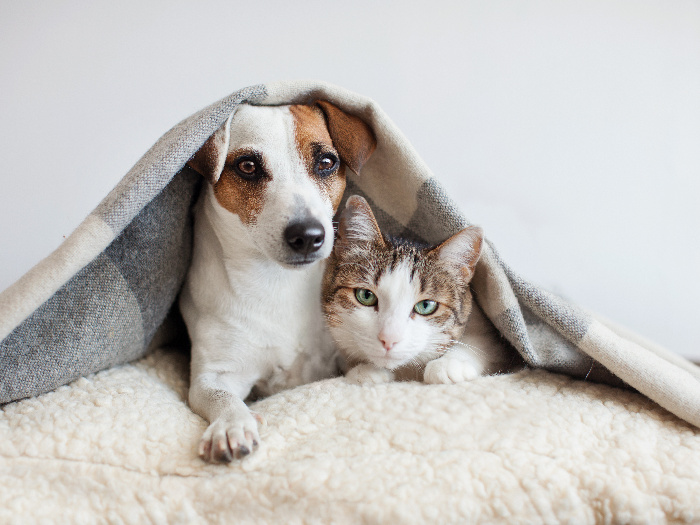One of the persistent problems that every pet parent has to deal with is fleas. Apart from being uncomfortable, fleas are itchy and can leave sores as the pets keep scratching themselves. To make matters worse, fleas are extremely difficult to remove from your pet’s environment. The eggs are almost impossible to take out and the adults can easily come back. Fortunately, there are many topical medications you can use to address this problem. Many people prefer using natural methods, such as tea tree oil for fleas.
But how safe is tea tree oil (TTO)? What are the correct procedures, precautions, and safer alternatives that you should know about?
What is Tea Tree Oil?
TTO is an essential oil that is obtained from the plant Melaleuca alternifolia. The tree is native to Australia where it was used for centuries for medicinal purposes, especially for its antiseptic, antimicrobial and anti-inflammatory properties. One of its popular applications is to treat acne. In vitro data from different researches supports these long-held beliefs. [1]

Is tea tree oil safe for your pets? Photo Credit: Shutterstock
Is Tea Tree Oil Safe For Pets?
The answer is no. Despite its antimicrobial properties, using tea tree oil for treating fleas is not the best route. Although there is some anecdotal evidence of its effectiveness, research has shown that it can also have adversarial effects. Many pet parents prefer to use tea tree oil because it is natural and that often equates with safe for most people. However, natural ingredients can be just as toxic. A study published in the Journal of the American Veterinary Medical Association found that 100 percent TTO can show highly adverse reactions in dogs and cats. This included: [2]
- Signs of CNS depression
- Salivation/drooling
- Lethargy
- Paresis
- Tremors
- Ataxia
It was especially toxic for younger and smaller cats or those with lighter bodyweight. Wrong dosage, application, or treatment can prove dangerous. It can be toxic if ingested in higher doses. The application of tea tree oil in high doses can cause adverse reactions. You must also check if your pet is allergic to tea tree oil.
Given the concerns regarding its safety, it is highly advisable that you talk to a vet before trying the oil.
What to Consider When Using Tea Tree Oil
If you are still keen on using tea tree oil, there are some necessary precautions that you must take:
- Never ingest: Tea tree oil can be toxic for humans as well as pets if ingested. So, never give it orally to your pet. Be careful when storing if you have children at home. It should ideally be stored in a cool and dark place, away from children and pets.
- Check the concentration: A high concentration of tea tree oil for topical application has shown negative outcomes. It is always best to dilute the oil before application. Many people use 100 percent tea tree oil around their home, believing that it is safe since they are not applying it on their skin. However, this is also unadvisable. Constant inhalation of such high concentration should be avoided.
- Avoid using for cats: As research has shown, cats are especially vulnerable to the toxicity of tea tree oil. In any case, the safe dosage for cats is so low that it may not even act against fleas.
- Talk to your vet: Always talk to your vet when using any medication for your dog. You can get the right dosage and the correct application.
How to Use Tea Tree Oil For Fleas?
When used in low concentration and sparingly, tea tree oil can be very effective against fleas:
For Repelling Fleas
Add 3-4 drops of tea tree oil to a quarter cup of water in a spray bottle. Spray this mixture on your clothes. The odor of the oil will keep the fleas away. If the odor is too strong, you can also add a few drops of more pleasant fragrance like lavender essential oil to the water.
For Treating Bites
Wash the insect bite with water and gentle soap. Prepare the tea tree oil dilution by adding 2 drops of the oil to a quarter cup of carrier oil like coconut oil and shake well. We prefer coconut oil because of its own inherent antiseptic properties. Dab this diluted mix on the bite with cotton.
On Your Dog
The safe concentration for dogs is 0.1 percent to 1 percent. For dogs weighing less than 7 kgs, the safe dosage is 3 drops in 2 oz of carrier oil. For heavier dogs, you can go with 8 drops. Before applying, give your pet a bath with water and soap. Gently dry and then apply the diluted oil. To begin, check if your dog is allergic to the oil by doing a patch test. If he/she shows irritation even after an hour, wash off the oil. If not, prepare for a wider application. Make sure that you lift the fur and apply it to the skin. You don’t have to cover your dog in oil. Make sure that he/she cannot accidentally lick it. We recommend putting it on the back.
For Using It Indoors
If your home has a flea infestation, you may want to use TTO to get rid of fleas. We recommend diluting it with eucalyptus/peppermint essential oil. You can add 20 ml of each of the two oils to a cup of witch hazel in a spray bottle and apply it all over your home. However, avoid using TTO if you have pets or small children, especially crawling babies. Any accidental licking can be toxic to them.
Finally, always talk to a vet or a doctor when applying TTO on children or pets. There are safer alternatives, some of them highly effective. Today you can also get specially formulated solutions that not only target fleas but also the eggs, making sure that your pet stays flea-free for a long time. These commercially available solutions are designed to be safe for pets and humans. For home remedies, please refer to our article on effective solutions.
